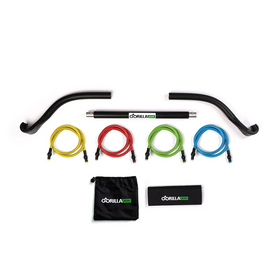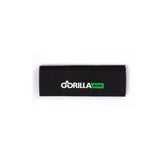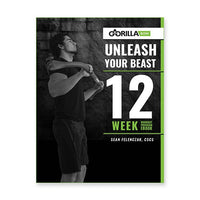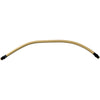12 Exercises That Help Increase Flexibility

In the fitness world, flexibility is all too often overlooked or underrated in most people's fitness routine. When exercising, flexibility helps your body move as a cohesive unit. Having a flexible body gives you incredible freedom to do anything you want, whether you’re working out or going through your day.
Do you want to improve your flexibility? This guide will show you the importance of flexibility and the best exercises to improve your range of motion.
Why Is Flexibility Important?
Exercise encompasses numerous activities you can do indoors and outdoors. Most sports demand strength, speed and flexibility, which is critical for a wide range of motion. Gymnastics, swimming, diving, football and dancing are prime examples of sports that require flexibility. Even table tennis requires tremendous flexibility with your wrists.
In addition to the athletic advantages, you should strive for flexibility because of its health benefits. With good flexibility, you lower your risk of injuries, improve blood flow and elevate performance while playing.
What Exercises Increase Flexibility?
When you become more flexible, you realize it’s a gift that helps numerous athletes daily. So, how can you improve your flexibility? Use these 12 exercises to improve your range of motion and reach your peak capabilities.
1. Archer Pulls
Archery is a simple concept only involving your arms, a bow and arrows. Flexibility is crucial in archery because your arm position directly affects your success. Archer pulls are an excellent exercise to prepare for your bow and arrow. Resistance bows and bands are terrific accompaniments to complete the training.
How to do them:
- Hold the Gorilla Bow in front of you like a bow and arrow.
- Use your left arm to hold the bow and your right arm to pull back the band.
- Pull back and forth for 30 seconds.
- Switch arms and repeat the exercise with three sets for each arm.
2. Fire Hydrant Hip Stretch
Your core is central to numerous exercises — a substantial core you maintain balance and stability. You can exercise your midsection by focusing on your stomach, lower back and hips. This fire hydrant hip stretch is ideal for your hip joints, whether you’re doing cardio or crushing deadlifts in the gym.
How to do them:
- Start by getting on your hands and knees. Ensure your hands are parallel to your shoulders and knees to your hips.
- With a tight core, lift your right leg from your body about 45 degrees in the air.
- Bring the leg down and repeat with the other leg. Do three sets of 15 reps for each leg.
3. Quad Stretch
Quad flexibility is critical in distance running and weightlifting. Stretched quads ensure your physical durability and safety while exercising. Plus, you’ll have a broader range of motion, especially by doing these quad stretches.
How to do them:
- Stand up straight with your feet together.
- Lift your right leg in the air, pulling your foot toward your glutes.
- Hold for 15 seconds.
- Release, then repeat with the other leg. Do three sets with each leg.
4. Hamstring Windmill Stretches
When stretching, there are two approaches you can take — dynamic or static. Dynamic stretches are preferable because they warm your body up more effectively. Research shows dynamic stretches increase your range of motion and decrease stiffness. Try dynamic stretching with hamstring windmill stretches.
How to do them:
- Spread your legs and bend forward, putting both hands on the floor.
- Raise your right hand in the air until it makes a 180-degree angle with your left arm.
- Bring down the arm and repeat with the left arm.
- Do three sets of 15 reps for each arm.
5. Walking Lunges
Sports like tennis — and the new rage, pickleball — require strength and speed. Lunges are an excellent all-around exercise because they work almost your entire lower body. You’ll see results in your hips, hamstrings, glutes, calves and core strength. Doing lunges also mitigates soreness following an exercise session. Walking lunges are a particularly worthwhile dynamic stretch.
How to do them:
- Stand straight with aligned feet and hips.
- Use your left leg to step forward and bend both knees at a 90-degree angle.
- As you rise, step forward with your right foot, repeating the process.
- Do three sets of 15 reps for each leg.
You can increase the difficulty by adding dumbbells or a Gorilla Bow Lite as you improve. This smaller version is only two pounds but can withstand 150 pounds of tension.
6. Squats
Leg day might not be everyone’s favorite, but it’s necessary for a reason. Your legs are generally bigger than your arms, requiring more oxygen. Thus, leg exercises increase your heart rate and leave you huffing and puffing. Squats are a terrific way to help flexibility and remain agile, even as you age.
How to do them:
- Stand up straight, spreading your legs just past your hips.
- Extend your arms straight ahead to help your balance.
- Bend your knees and lower your glutes as if preparing to sit in a chair.
- Return to the starting position. Do three sets of 15 reps.
Squats are easy to mess up, so ensure your form is correct before doing multiple sets. For example, some typical squatting mistakes include not going low enough, collapsing your knees or rounding your lower back. These minor mistakes can reduce the effectiveness of the squats or cause injuries.
7. Hip Thrusts
Another suitable exercise for your lower body and core is hip thrusts. This regimen is terrific in strength training because it targets your pelvis, glutes, quads and hips. Many people use barbells in their hip thrusts, but you can do them at home or on the go with Gorilla Bow Travel. This equipment has three 21-inch sections you can disassemble and pack in your bags. Its max capacity goes up to 350 pounds of tension.
How to do them with a Gorilla Bow:
- Lie on your back, putting your feet on the Gorilla Bow.
- Ensure the band stretches over your waist.
- Engage your core and lift your glutes a few inches off the ground, raising your hips as high as possible.
- Bring your body back down and repeat. Do three sets of 15 reps.
8. Butterfly Stretches
Dynamic stretches help before your workout, but static stretches can be helpful when you cool down after exercise. Butterfly stretches are a terrific regimen to help your flexibility and cool down your muscles. This exercise helps stretch your inner adductor muscles, aiding your stability and balance.
How to do them:
- Sit on the floor with a straightened back.
- Connect the soles of your feet with your knees extended on the side. Your lower body should resemble butterfly wings.
- Grab your ankles and lower your legs, stretching your inner thighs. You can use your hands to push your knees if necessary.
- Hold the stretch for one minute, release it, then repeat for three sets.
9. Lying Quad Stretch
Another popular cooldown exercise is the lying quad stretch. Caring for your quads is essential, especially if you’ve completed cardio-centric workouts like cycling or jogging. These lying quad stretches can reduce your recovery time and increase your range of motion.
How to do them:
- Lie on the ground and turn over to your left side.
- Bend your right leg, keeping your left leg still on the bottom.
- Bring your right foot to your glutes, using your hand to keep it steady.
- Hold for one minute, then release.
- Switch to your other leg and repeat.
10. Leg Pendulum
If you’re looking for more dynamic stretches, leg pendulums are a tremendous exercise to warm up. This activity readies your hip muscles and hips for any workout involving your legs. After doing a few sets, your legs will have a much better range of motion.
How to do them:
- Stand up straight with aligned feet and hips.
- Keep your right leg still and extend your left leg forward as far as possible.
- Bring your left leg back and extend it behind you as far as you can. Your leg should resemble a pendulum on a clock.
- After going up and down once, repeat with the right leg.
- Do three sets of 15 reps for each leg.
11. Frog Stretch
Another good warm-up stretch for runners is the frog pose. It’s excellent for increasing flexibility, especially in your core and around your hips. You can also use the frog stretch as a cooldown exercise to alleviate lower back pain, considering you also stretch your back muscles.
- Start by getting on the ground on all fours.
- Spread your legs apart, ensuring your knees extend past your shoulders.
- Extend your toe tips outward and rest your feet on the floor.
- Move your hips and glutes back toward your feet.
- Hold for one minute. Release, then do three sets total.
12. Downward Dog
People have practiced yoga for centuries, providing excellent physiological and psychological benefits. Whatever your fitness goals, yoga poses can elevate your routine and increase flexibility. Take the downward dog stance as an example. This pose stretches your hamstrings and readies your Achilles tendon.
How to do the downward dog:
- Get on the ground on all fours, placing your knees behind your hips.
- Elevate your knees and glutes into the air as if creating a V with your body.
- Extend your back and keep your legs loose to prevent injury.
- Hold the pose for one minute and release. Repeat for three sets.
Using Stretches for Flexibility
Flexibility is at the core of any fitness routine. You need it to move efficiently, keep your body safe and ensure a wide range of motion. Your flexibility is also crucial while idle because it affects your posture.
Flexibility is also crucial as you age. You want to maintain good physical health as your body naturally declines, so find time to stretch in your fitness routine. Use these 12 exercises to improve your flexibility and maximize your workouts.










Leave a comment